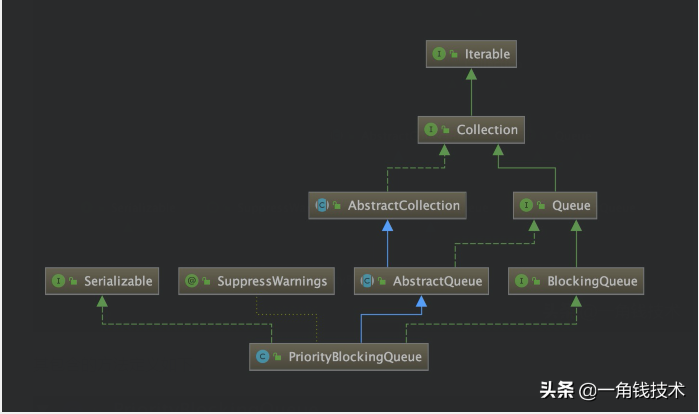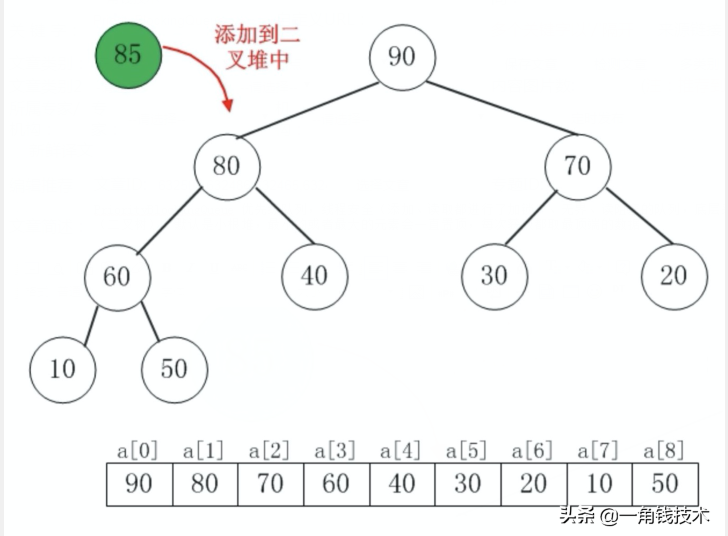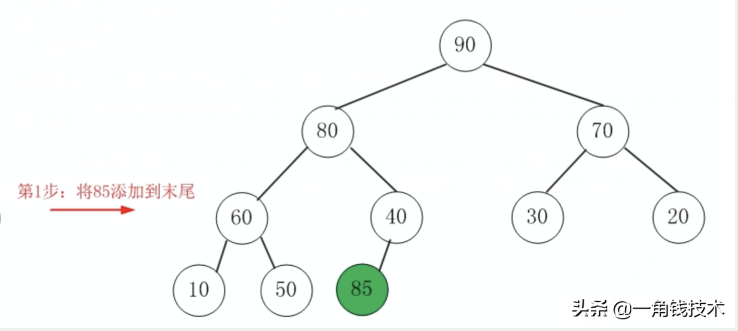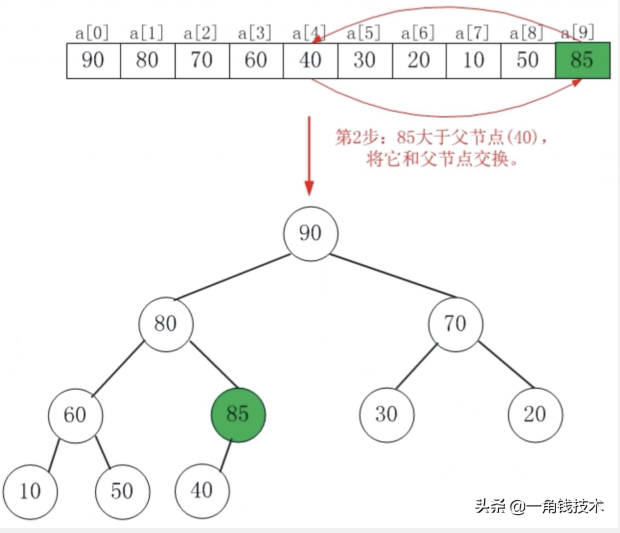前言
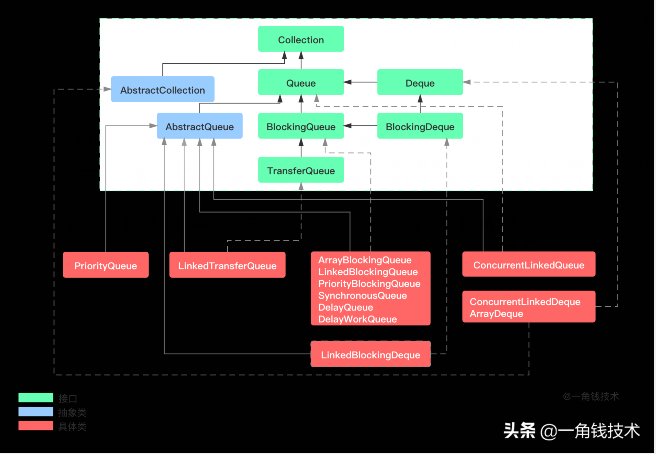
PriorityBlockingQueue 优先级队列,线程安全(添加、读取都进行了加锁)、无界、读阻塞的队列,底层采用的堆结构实现(二叉树),默认是小根堆,最小的或者最大的元素会一直置顶,每次获取都取最顶端的数据
队列创建
小根堆
- PriorityBlockingQueue<Integer> concurrentLinkedQueue = new PriorityBlockingQueue<Integer>();
大根堆
- PriorityBlockingQueue<Integer> concurrentLinkedQueue = new PriorityBlockingQueue<Integer>(10, new Comparator<Integer>() {
- @Override
- public int compare(Integer o1, Integer o2) {
- return o2 - o1;
- }
- });
应用场景
有任务要执行,可以对任务加一个优先级的权重,这样队列会识别出来,对该任务优先进行出队。
我们来看一个具体例子,例子中定义了一个将要放入“优先阻塞队列”的任务类,并且定义了一个任务工场类和一个任务执行类,在任务工场类中产生了各种不同优先级的任务,将其添加到队列中,在任务执行类中,任务被一个个取出并执行。
- package com.niuh.queue.priority;
- import java.util.ArrayList;
- import java.util.List;
- import java.util.Queue;
- import java.util.Random;
- import java.util.concurrent.ExecutorService;
- import java.util.concurrent.Executors;
- import java.util.concurrent.PriorityBlockingQueue;
- import java.util.concurrent.TimeUnit;
- /**
- * <p>
- * PriorityBlockingQueue使用示例
- * </p>
- */
- public class PriorityBlockingQueueDemo {
- public static void main(String[] args) throws Exception {
- Random random = new Random(47);
- ExecutorService exec = Executors.newCachedThreadPool();
- PriorityBlockingQueue<Runnable> queue = new PriorityBlockingQueue<>();
- exec.execute(new PrioritizedTaskProducer(queue, exec)); // 这里需要注意,往PriorityBlockingQueue中添加任务和取出任务的
- exec.execute(new PrioritizedTaskConsumer(queue)); // 步骤是同时进行的,因而输出结果并不一定是有序的
- }
- }
- class PrioritizedTask implements Runnable, Comparable<PrioritizedTask> {
- private Random random = new Random(47);
- private static int counter = 0;
- private final int id = counter++;
- private final int priority;
- protected static List<PrioritizedTask> sequence = new ArrayList<>();
- public PrioritizedTask(int priority) {
- this.priority = priority;
- sequence.add(this);
- }
- @Override
- public int compareTo(PrioritizedTask o) {
- return priority < o.priority ? 1 : (priority > o.priority ? -1 : 0); // 定义优先级计算方式
- }
- @Override
- public void run() {
- try {
- TimeUnit.MILLISECONDS.sleep(random.nextInt(250));
- } catch (InterruptedException e) {
- }
- System.out.println(this);
- }
- @Override
- public String toString() {
- return String.format("[%1$-3d]", priority) + " Task " + id;
- }
- public String summary() {
- return "(" + id + ": " + priority + ")";
- }
- public static class EndSentinel extends PrioritizedTask {
- private ExecutorService exec;
- public EndSentinel(ExecutorService exec) {
- super(-1);
- this.exec = exec;
- }
- @Override
- public void run() {
- int count = 0;
- for (PrioritizedTask pt : sequence) {
- System.out.print(pt.summary());
- if (++count % 5 == 0) {
- System.out.println();
- }
- }
- System.out.println();
- System.out.println(this + " Calling shutdownNow()");
- exec.shutdownNow();
- }
- }
- }
- class PrioritizedTaskProducer implements Runnable {
- private Random random = new Random(47);
- private Queue<Runnable> queue;
- private ExecutorService exec;
- public PrioritizedTaskProducer(Queue<Runnable> queue, ExecutorService exec) {
- this.queue = queue;
- this.exec = exec;
- }
- @Override
- public void run() {
- for (int i = 0; i < 20; i++) {
- queue.add(new PrioritizedTask(random.nextInt(10))); // 往PriorityBlockingQueue中添加随机优先级的任务
- Thread.yield();
- }
- try {
- for (int i = 0; i < 10; i++) {
- TimeUnit.MILLISECONDS.sleep(250);
- queue.add(new PrioritizedTask(10)); // 往PriorityBlockingQueue中添加优先级为10的任务
- }
- for (int i = 0; i < 10; i++) {
- queue.add(new PrioritizedTask(i));// 往PriorityBlockingQueue中添加优先级为1-10的任务
- }
- queue.add(new PrioritizedTask.EndSentinel(exec));
- } catch (InterruptedException e) {
- }
- System.out.println("Finished PrioritizedTaskProducer");
- }
- }
- class PrioritizedTaskConsumer implements Runnable {
- private PriorityBlockingQueue<Runnable> queue;
- public PrioritizedTaskConsumer(PriorityBlockingQueue<Runnable> queue) {
- this.queue = queue;
- }
- @Override
- public void run() {
- try {
- while (!Thread.interrupted()) {
- queue.take().run(); // 任务的消费者,从PriorityBlockingQueue中取出任务执行
- }
- } catch (InterruptedException e) {
- }
- System.out.println("Finished PrioritizedTaskConsumer");
- }
- }
工作原理
PriorityBlockingQueue 是 JDK1.5 的时候出来的一个阻塞队列。但是该队列入队的时候是不会阻塞的,永远会加到队尾。下面我们介绍下它的几个特点:
- PriorityBlockingQueue 和 ArrayBlockingQueue 一样是基于数组实现的,但后者在初始化时需要指定长度,前者默认长度是 11。
- 该队列可以说是真正的无界队列,它在队列满的时候会进行扩容,而前面说的无界阻塞队列其实都有有界,只是界限太大可以忽略(最大值是 2147483647)
- 该队列属于权重队列,可以理解为它可以进行排序,但是排序不是从小到大排或从大到小排,是基于数组的堆结构(具体如何排下面会进行分析)
- 出队方式和前面的也不同,是根据权重来进行出队,和前面所说队列中那种先进先出或者先进后出方式不同。
- 其存入的元素必须实现Comparator,或者在创建队列的时候自定义Comparator。
注意:
- 堆结构实际上是一种完全二叉树。关于二叉树可以查看 《树、二叉树、二叉搜索树的实现和特性》
- 堆又分为大顶堆和小顶堆 。大顶堆中第一个元素肯定是所有元素中最大的,小顶堆中第一个元素是所有元素中最小的。关于二叉堆可以查看《堆和二叉堆的实现和特性》
源码分析
定义
PriorityBlockingQueue的类继承关系如下:
其包含的方法定义如下:
成员属性
从下面的字段我们可以知道,该队列可以排序,使用显示锁来保证操作的原子性,在空队列时,出队线程会堵塞等。
- /**
- * 默认数组长度
- */
- private static final int DEFAULT_INITIAL_CAPACITY = 11;
- /**
- * 最大达容量,分配时超出可能会出现 OutOfMemoryError 异常
- */
- private static final int MAX_ARRAY_SIZE = Integer.MAX_VALUE - 8;
- /**
- * 队列,存储我们的元素
- */
- private transient Object[] queue;
- /**
- * 队列长度
- */
- private transient int size;
- /**
- * 比较器,入队进行权重的比较
- */
- private transient Comparator<? super E> comparator;
- /**
- * 显示锁
- */
- private final ReentrantLock lock;
- /**
- * 空队列时进行线程阻塞的 Condition 对象
- */
- private final Condition notEmpty;
构造函数
- /**
- * 默认构造,使用长度为 11 的数组,比较器为空
- */
- public PriorityBlockingQueue() {
- this(DEFAULT_INITIAL_CAPACITY, null);
- }
- /**
- * 自定义数据长度构造,比较器为空
- */
- public PriorityBlockingQueue(int initialCapacity) {
- this(initialCapacity, null);
- }
- /**
- * 自定义数组长度,可以自定义比较器
- */
- public PriorityBlockingQueue(int initialCapacity,
- Comparator<? super E> comparator) {
- if (initialCapacity < 1)
- throw new IllegalArgumentException();
- this.lock = new ReentrantLock();
- this.notEmpty = lock.newCondition();
- this.comparator = comparator;
- this.queue = new Object[initialCapacity];
- }
- /**
- * 构造函数,带有初始内容的队列
- */
- public PriorityBlockingQueue(Collection<? extends E> c) {
- this.lock = new ReentrantLock();
- this.notEmpty = lock.newCondition();
- boolean heapify = true; // true if not known to be in heap order
- boolean screen = true; // true if must screen for nulls
- if (c instanceof SortedSet<?>) {
- SortedSet<? extends E> ss = (SortedSet<? extends E>) c;
- this.comparator = (Comparator<? super E>) ss.comparator();
- heapify = false;
- }
- else if (c instanceof PriorityBlockingQueue<?>) {
- PriorityBlockingQueue<? extends E> pq =
- (PriorityBlockingQueue<? extends E>) c;
- this.comparator = (Comparator<? super E>) pq.comparator();
- screen = false;
- if (pq.getClass() == PriorityBlockingQueue.class) // exact match
- heapify = false;
- }
- Object[] a = c.toArray();
- int n = a.length;
- // If c.toArray incorrectly doesn't return Object[], copy it.
- if (a.getClass() != Object[].class)
- a = Arrays.copyOf(a, n, Object[].class);
- if (screen && (n == 1 || this.comparator != null)) {
- for (int i = 0; i < n; ++i)
- if (a[i] == null)
- throw new NullPointerException();
- }
- this.queue = a;
- this.size = n;
- if (heapify)
- heapify();
- }
入队方法
入队方法,下面可以看到 put 方法最终会调用 offer 方法,所以我们只看 offer 方法即可。
offer(E e)
- public void put(E e) {
- offer(e); // never need to block
- }
- public boolean offer(E e) {
- //判断是否为空
- if (e == null)
- throw new NullPointerException();
- //显示锁
- final ReentrantLock lock = this.lock;
- lock.lock();
- //定义临时对象
- int n, cap;
- Object[] array;
- //判断数组是否满了
- while ((n = size) >= (cap = (array = queue).length))
- //数组扩容
- tryGrow(array, cap);
- try {
- //拿到比较器
- Comparator<? super E> cmp = comparator;
- //判断是否有自定义比较器
- if (cmp == null)
- //堆上浮
- siftUpComparable(n, e, array);
- else
- //使用自定义比较器进行堆上浮
- siftUpUsingComparator(n, e, array, cmp);
- //队列长度 +1
- size = n + 1;
- //唤醒休眠的出队线程
- notEmpty.signal();
- } finally {
- //释放锁
- lock.unlock();
- }
- return true;
- }
siftUpComparable(int k, T x, Object[] array)
上浮调整比较器方法的实现
- private static <T> void siftUpComparable(int k, T x, Object[] array) {
- Comparable<? super T> key = (Comparable<? super T>) x;
- while (k > 0) {
- //无符号向左移,目的是找到放入位置的父节点
- int parent = (k - 1) >>> 1;
- //拿到父节点的值
- Object e = array[parent];
- //比较是否大于该元素,不大于就没比较交换
- if (key.compareTo((T) e) >= 0)
- break;
- //以下都是元素位置交换
- array[k] = e;
- k = parent;
- }
- array[k] = key;
- }
根据上面的代码,可以看出这是完全二叉树在进行上浮调整。调整入队的元素,找出最小的,将元素排列有序化。简单理解就是:父节点元素值一定要比它的子节点得小,如果父节点大于子节点了,那就两者位置进行交换。
入队图解
例子:85 添加到二叉堆中(大顶堆)
- package com.niuh.queue.priority;
- import java.util.Comparator;
- import java.util.concurrent.PriorityBlockingQueue;
- /**
- * <p>
- * PriorityBlockingQueue 简单演示 demo
- * </p>
- */
- public class TestPriorityBlockingQueue {
- public static void main(String[] args) throws InterruptedException {
- // 大顶堆
- PriorityBlockingQueue<Integer> concurrentLinkedQueue = new PriorityBlockingQueue<Integer>(10, new Comparator<Integer>() {
- @Override
- public int compare(Integer o1, Integer o2) {
- return o2 - o1;
- }
- });
- concurrentLinkedQueue.offer(90);
- concurrentLinkedQueue.offer(80);
- concurrentLinkedQueue.offer(70);
- concurrentLinkedQueue.offer(60);
- concurrentLinkedQueue.offer(40);
- concurrentLinkedQueue.offer(30);
- concurrentLinkedQueue.offer(20);
- concurrentLinkedQueue.offer(10);
- concurrentLinkedQueue.offer(50);
- concurrentLinkedQueue.offer(85);
- //输出元素排列
- concurrentLinkedQueue.stream().forEach(e-> System.out.print(e+" "));
- //取出元素
- Integer take = concurrentLinkedQueue.take();
- System.out.println();
- concurrentLinkedQueue.stream().forEach(e-> System.out.print(e+" "));
- }
- }
操作的细节分为两步:
- 第一步:首先把新元素插入到堆的尾部再说;(新的元素可能是特别大或者特别小,那么要做的一件事情就是重新维护一下堆的所有元素,把新元素挪到这个堆的相应的位置)
- 第二步:依次向上调整整个堆的结构,就叫 HeapifyUp
85 按照上面讲的先插入到堆的尾部,也就是一维数组的尾部,一维数组的尾部的话就上图的位置,因为这是一个完全二叉树,所以它的尾部就是50后面这个结点。插进来之后这个时候就破坏了堆,它的每一个结点都要大于它的儿子的这种属性了,接下来要做的事情就是要把 85 依次地向上浮动,怎么浮动?就是 85 大于它的父亲结点,那么就和父亲结点进行交换,直到走到根如果大于根的话,就和根也进行交换。
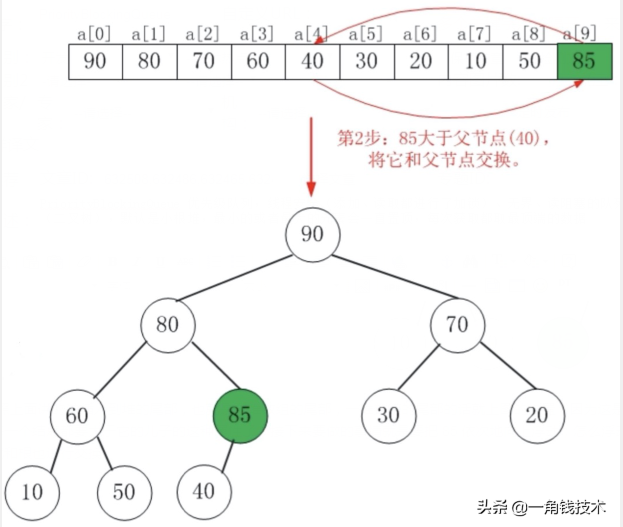
85 再继续往前走之后,它要和 80 再进行比较,同理可得:也就是说这个结点每次和它的父亲比,如果它大于它的父亲的话就交换,直到它不再大于它的父亲。
出队方法
入队列的方法说完后,我们来说说出队列的方法。PriorityBlockingQueue提供了多种出队操作的实现来满足不同情况下的需求,如下:
- E take();
- E poll();
- E poll(long timeout, TimeUnit unit);
- E peek()
poll 和 peek 与上面类似,这里不做说明
take()
出队方法,该方法会阻塞
- public E take() throws InterruptedException {
- //显示锁
- final ReentrantLock lock = this.lock;
- //可中断锁
- lock.lockInterruptibly();
- //结果接收对象
- E result;
- try {
- //判断队列是否为空
- while ( (result = dequeue()) == null)
- //线程阻塞
- notEmpty.await();
- } finally {
- lock.unlock();
- }
- return result;
- }
dequeue()
我们再来看看具体出队方法的实现,dequeue方法
- private E dequeue() {
- //长度减少 1
- int n = size - 1;
- //判断队列中是否有元素
- if (n < 0)
- return null;
- else {
- //队列对象
- Object[] array = queue;
- //取出第一个元素
- E result = (E) array[0];
- //拿出最后一个元素
- E x = (E) array[n];
- //置空
- array[n] = null;
- Comparator<? super E> cmp = comparator;
- if (cmp == null)
- //下沉调整
- siftDownComparable(0, x, array, n);
- else
- siftDownUsingComparator(0, x, array, n, cmp);
- //成功则减少队列中的元素数量
- size = n;
- return result;
- }
总体就是找到父节点与两个子节点中最小的一个节点,然后进行交换位置,不断重复,由上而下的交换。
siftDownComparable(int k, T x, Object[] array, int n)
再来看看下沉比较器方法的实现
- private static <T> void siftDownComparable(int k, T x, Object[] array,
- int n) {
- //判断队列长度
- if (n > 0) {
- Comparable<? super T> key = (Comparable<? super T>)x;
- //找到队列最后一个元素的父节点的索引。
- int half = n >>> 1; // loop while a non-leaf
- while (k < half) {
- //拿到 k 节点下的左子节点
- int child = (k << 1) + 1; // assume left child is least
- //取得子节点对应的值
- Object c = array[child];
- //取得 k 右子节点的索引
- int right = child + 1;
- //比较右节点的索引是否小于队列长度和左右子节点的值进行比较
- if (right < n &&
- ((Comparable<? super T>) c).compareTo((T) array[right]) > 0)
- c = array[child = right];
- //比较父节点值是否大于子节点
- if (key.compareTo((T) c) <= 0)
- break;
- //下面都是元素替换
- array[k] = c;
- k = child;
- }
- array[k] = key;
- }
- }
出队图解
将堆尾元素替换到顶部(即堆顶被替代删除掉)
依次从根部向下调整整个堆的结构(一直到堆尾即可) HeapifyDown
例子:90 从二叉堆中删除(大顶堆)
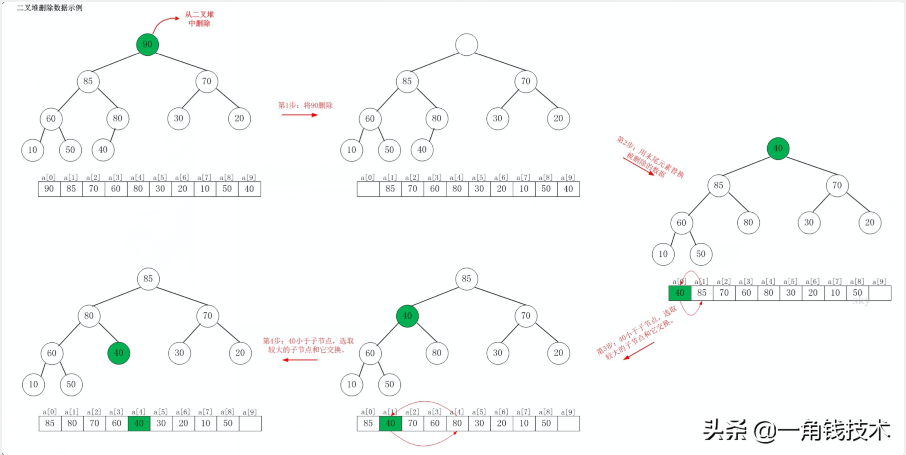
总结
PriorityBlockingQueue 真的是个神奇的队列,可以实现优先出队。最特别的是它只有一个锁,入队操作永远成功,而出队只有在空队列的时候才会进行线程阻塞。可以说有一定的应用场景吧,比如:有任务要执行,可以对任务加一个优先级的权重,这样队列会识别出来,对该任务优先进行出队。














